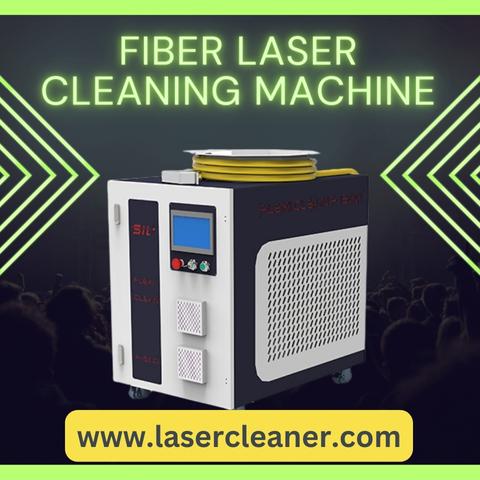Fiber Laser Cleaning Machine for Efficient Rust, Paint, and Coating Removal Across Industries

In industrial sectors where precision, efficiency, and cost control are critical, the fiber laser cleaning machine has emerged as a game-changing technology. This equipment has transformed how companies deal with rust, paint, oil, oxides, and other surface contaminants that affect the quality and durability of metals and other materials. Unlike conventional methods that rely on abrasive blasting, harmful chemicals, or manual scrubbing, the fiber laser cleaning machine provides a contactless and highly accurate method of cleaning surfaces.
Over the last decade, its adoption has grown across automotive, aerospace, shipbuilding, manufacturing, and even cultural restoration sectors. Its strength lies not only in cleaning but also in maintaining the integrity of the base material, which is often compromised by traditional cleaning methods. For industries where material preservation and environmental compliance are priorities, this machine is proving to be an essential investment.
In this detailed guide, we will explore how fiber laser cleaning works, the industries using it, the process efficiency, cost-effectiveness, and the role it plays in ensuring long-term productivity. At the end, readers will have a clear understanding of why this machine has become a cornerstone of modern industrial cleaning systems. In this guide we will explain in English language.
Understanding Fiber Laser Cleaning Technology
A fiber laser cleaning machine operates by directing a focused laser beam onto a contaminated surface. The laser energy is absorbed by the rust, paint, or coating layer, causing it to evaporate or peel off without damaging the base metal. This process is highly controlled, ensuring precision cleaning with minimal material wastage.
The core principle is based on the difference in absorption between contaminants and the underlying material. Rust and oxides, for example, absorb laser energy at different rates compared to steel or aluminum. This selective absorption makes it possible to strip only unwanted layers while keeping the base intact.
Fiber lasers are built on solid-state technology, which makes them reliable, long-lasting, and stable for industrial applications. Unlike gas or crystal lasers, they require less maintenance and provide consistent performance, even under heavy workloads.
Why Industries are Choosing Fiber Laser Cleaning Machines
Across sectors, cleaning surfaces efficiently has always been a challenge. Traditional methods often involve sandblasting, grinding, or using chemical solvents. These practices are not only labor-intensive but also raise safety and environmental concerns.
The fiber laser cleaning machine addresses these challenges in a systematic way. It provides a dry, eco-friendly, and low-maintenance cleaning method that eliminates the need for harmful chemicals or abrasive materials. More importantly, the technology reduces downtime, which is vital in industries where production schedules are tight.
In automotive manufacturing, for instance, preparing metal parts before welding or coating is critical. A laser system can clean parts quickly, ensuring higher weld quality and reducing rework. Similarly, in aerospace, where precision is non-negotiable, laser cleaning ensures components remain free from contamination without any mechanical stress.
Applications Across Different Industries
The fiber laser cleaning machine is not limited to a single sector. Its versatility makes it valuable in a wide range of applications:
-
Rust Removal – Common in shipbuilding, construction, and automotive repair industries. Rust weakens metals and shortens their life span. Laser cleaning removes corrosion effectively without thinning or weakening the base material.
-
Paint and Coating Removal – Widely used when preparing surfaces for recoating or refurbishment. The machine strips coatings cleanly without requiring multiple manual processes.
-
Oil and Grease Cleaning – Manufacturing plants often deal with oil residues that interfere with welding or coating. Laser cleaning ensures surfaces are free from contamination.
-
Oxide Layer Removal – In industries like aerospace and electronics, removing oxide layers is crucial before joining or bonding processes.
-
Cultural Heritage Restoration – Museums and restoration experts use fiber lasers to clean delicate stone, bronze, and artworks without damaging original structures.
-
Nuclear and Power Plant Maintenance – The non-contact cleaning process is safe for decontamination work where radioactive residues must be handled carefully.
Operational Efficiency of Fiber Laser Cleaning
One of the reasons the fiber laser cleaning machine is gaining popularity is its operational efficiency. It minimizes labor requirements while offering consistent results across different tasks. Unlike manual cleaning, which depends on worker skill and effort, laser cleaning is automated, repeatable, and precise.
Moreover, the machine can be adjusted for different power levels, pulse frequencies, and scanning speeds, making it adaptable for various surface conditions. For instance, light cleaning of grease may require lower power, while thick rust removal demands higher intensity. This flexibility makes it suitable for both delicate and heavy-duty work.
Long-Term Cost-Effectiveness
When evaluating industrial equipment, businesses consider both upfront costs and long-term savings. A fiber laser cleaning machine may seem like a significant investment at first, but the savings it generates quickly balance the expense.
By eliminating consumables like sand, brushes, or chemical solvents, it reduces recurring costs. The system’s low maintenance requirements also cut down on service expenses. Additionally, by increasing the lifespan of machinery and improving product quality, companies reduce waste and rework, further enhancing cost-effectiveness.
Safety and Environmental Role
In today’s industries, environmental responsibility and worker safety are more important than ever. Traditional cleaning methods generate dust, waste, and chemical fumes, which pose risks to both employees and the environment.
The fiber laser cleaning machine plays a role in ensuring compliance with environmental standards by offering a non-chemical, waste-free solution. Since the process generates minimal residue and no secondary waste, disposal costs are significantly reduced.
For workers, it reduces direct contact with hazardous materials, making workplaces safer and healthier. By integrating dust extraction systems and enclosures, companies further enhance safety while maintaining operational efficiency.
Integration in Modern Manufacturing
As industries transition toward automation and smart manufacturing, the fiber laser cleaning machine fits seamlessly into these systems. Many machines come with robotic arms, CNC controls, and automated setups, allowing them to operate within larger production lines.
This level of integration ensures high throughput, minimal downtime, and consistent quality. For companies aiming to increase efficiency while reducing operational costs, incorporating fiber laser cleaning into their production lines is a logical step forward.
Future Outlook of Fiber Laser Cleaning
The demand for fiber laser cleaning machines is expected to grow as more industries recognize the limitations of traditional cleaning methods. With governments tightening regulations on chemical use and waste management, companies are turning to environmentally friendly solutions.
Furthermore, advancements in laser technology are leading to more compact, energy-efficient, and versatile machines. These improvements will likely reduce costs and make fiber laser cleaning accessible to smaller manufacturers as well.
Final Thoughts
The fiber laser cleaning machine has redefined how industries approach surface cleaning and preparation. Its role extends beyond rust removal or paint stripping; it provides a sustainable, precise, and cost-effective solution that aligns with modern manufacturing demands.
From automotive plants to aerospace facilities, and from shipyards to restoration workshops, this machine has proven its ability to enhance quality and productivity. As industries evolve, the fiber laser cleaning machine will continue to stand as a reliable technology, ensuring surfaces remain clean, safe, and ready for use in critical applications.








